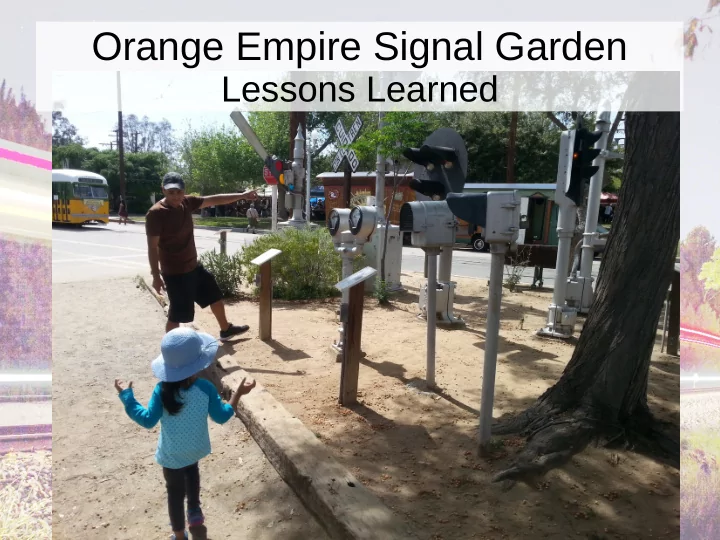

Typical Wiring Path .. the input relay (it's final destination):
Roadmap
Mysteries Why is the signal box full of grass? (This isn't a nest of any sort, just a bunch of grass) Much later – tried to drop a wire down a 4” pipe and failed. Birds nests (2 of them)
ACME Traffic Signal Head #1 Birds nest #3. Nest constructed during restoration. Found while I was on top of the ladder when the bird flew out on full afterburner.
ACME Traffic Signal Head #2 Arms removed temporarily for maintenance (For 10+ years) Leaving small round holes at the top.
ACME Traffic Signal Head #2 Arms removed for maintenance (For 10+ years) Leaving small round holes at the top. Bird's nests #4, #5, #6, #7.
Removed
Next task: Figure out what I've got ● Entire layout was probed. ● Every wire was labeled (or so I thought) New Linux controller designed, and extensively tested before deployment.
Deployment The plan: 1) Open cabinet 2) Remove old controller 3) Install new controller Four hour job – maximum
Deployment Actuality 1. Open cabinet 2. Quickly close cabinet 3. Go to Home Depot, get work gloves and spider spray. 4. Open cabinet 5. Kill black widow 6. Remove web and dead spider. 7. Carefully proceed with installation
Mistake #1 I assumed that the wires went like this: Signal Label Label Label Computer Instead they went like this Signal Label Term. Block Term. Block Label Label Computer After removal I had a bunch of this: Signal Label
Rework ● All wires had to be re-identified. ● 4 hours of work took about 3 months of weekends.
Alpha testing Button was designed to start signal when pressed. Stop on second press or timeout. Alpha testers had different ideas.
Problem #1: Input controller going offline ● Input controller was disappearing from the USB bus. ● Happened every time a wig wag stopped sounding. ● Ran through a bunch of USB hubs trying to figure out the problem.
Cause ● Wig wags have huge magnets. (Two of them.) ● Turning off a big magnet generates a big energy pulse ● … which then goes down the common ground wire and ● … causes the input controller to reset. ● – – – and later fry.
Fix #1 ● Huge capacitor ● Result fried input board.
Fix #2: Flyback Diode Result: Fewer problems – but still problems.
Fix #3: Relay isolation and flyback diodes +12v Signal GND Input GND Input Controller ● Result: The system mostly works. Now it's all USB problems.
Alpha testing: Operators ● Wrote a page of instructions for the docents concerning: 1) Turning the system on 2) Turning the system off 3) Recovering from hangs
Docent's Reality 1) If the garden's down, turn the whole thing off and back on. 2) If it's still down, call Steve.
RTC ● Raspberry PI has no RTC. ● Resetting power causes it to loose track of time. ● USB problems prevent the system from getting time from the network.
RTC ● Raspberry PI's solution, “fake hardware clock” ● When shutting down, record the time ● When starting up, use this time to set the time of day. ● Good for keeping time marching forward ● Lousy for turning on the garden in the morning.
Solution: DS3231 RTC ● Small I2C board that sits on the Raspberry PI GPIO connector.
RTC Programming ● Must enable I2C bus in /boot/config.txt ● Need new packages: i2c-tools ● Requires a bit of configuration: – Tell the I2C system you have a RTC – Tell udev to create devices for it – Tell systemd to start and stop it
Lesson #2: USB and USB Hubs ● Raspberry PI did not have enough USB power to power the devices (relay board, input board, wifi). ● Almost all powered hubs will backpower the Raspberry pi. – With an inadequate amount of power. ● Two power supplies fight each other and the Raspberry Pi looses.
Solution: Model B ● 4 USB ports. ● Enough power to make everything work.
Next Project: The Semaphore
Semaphore Guts
Semaphore Restoration ● Picture is not what I got originally – I cleaned it up before taking the picture. ● Found service manual on the Internet. ● Got a second mechanism off the Internet, but – One part arrived damaged – The only part, the only vital part – That I happened to have a spare for
New Feature Request Demand! It's nice that you got the crossing bells to work. Now make its stop. Request made a board of directors member who was trying to hold a meeting next door. Easily programmed in Linux.
Future Work ● Acme Traffic Signal Improvements Planned: New controller ● First a look at the old (1930) controller
Controller
Controller
Controller
Linux Controller Plans Raspberry PI Signal Head Signal Head Relay Board Video
Lessons Learned (General) ● You can accomplish a lot with a vacuum cleaner and cleaning rag. ● Perris, CA is an ideal climate for the black widow spider. ● Never assume that previous engineers who deigned your system were sane. ● Document well (and correctly) for those that come after you.
Lessons Learned (Electrical) ● Very large inductors create a very large energy pulse when turned off. ● Flyback didoes ● Isolation ● Cross talk ● Common grounds suck. ● Circuit isolation (computer and signal use different wires totally)
Lessons Learned (Restoration / Design) ● Talk to people who know more than you do – Preferably before you ruin equipment. ● Patent searches are useful for finding historical documents. ● You can find lots of old manuals on the Internet.
Lesson Learned Linux ● Lots of hooks into low level drivers – USB – Keyboard – GPIO – I2C/RTC ● USB Hubs – most are badly built – Avoid them
Recommend
More recommend